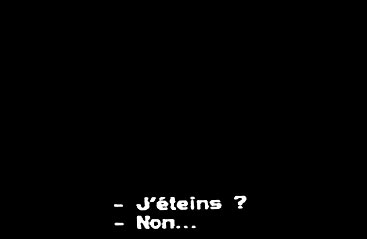
Born in 1950 in Orléans (FR)
Lives and works in Paris (FR)

1989
Black and white photograph, gelatin-silver print
82 x 121,5 cm
Year of Purchase: 1995
Éric Rondepierre’s disconcerting images are real but invisible. They are the result of a painstaking study of films prior to the 1960s, in which the cinematographic flaws which are imperceptible at normal projection speed, create rare juxtapositions, full of meaning.
He photographs the television screen which has been used for his laborious research, and freezes black images where all that remains is the subtitling. These fleeting black surfaces usually result from the restoration of a deteriorated copy. The image has disappeared, and just the text remains, inviting us to make many varied interpretations.
The artist excerpts from its context a phrase or repost whose meaning shifts towards irony and comicalness through the juxtaposition with the black image. In this way the photogram Le Voyeur reveals the coherence of haphazardness. ‘—Shall I turn it off? — No…’ is associated with the image of the darkened screen.
The title has a predominant place in the making of the work, it is not confined to labelling the photograph, but rather creates a different narrative. Le Voyeur refers not only to the film’s subtitling, but also to the position of the spectator, a ‘voyeur’ looking at the screen.
Rondepierre happily makes us lose our bearings by complicating his technique, and accumulating reproduction processes. The photograms act as models for a painting on canvas. The canvas is once again photographed, then destroyed. All that remains of this work is the very last photograph of the painting. Using links, and the deconstruction of methods traditionally connected with photography, Rondepierre hijacks models, the better to reveal the many interstices of the cinematographic image.
His work belongs to the movement of artists, such as Douglas Gordon, for whom film is emerging as a productive reference and not as a model.
Anne Langlois